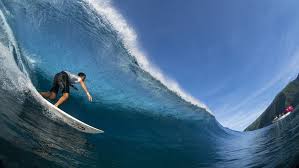Introduction to Surfing at Paris 2024
Surfing returned for its second Olympic appearance in the Paris 2024 Summer Olympics, but this time, the competition wasn’t held in mainland France. Instead, it took place more than 15,000 km away in Teahupo’o, Tahiti, one of the most legendary—and dangerous—surf breaks in the world.
This bold decision brought Olympic surfing to the heart of French Polynesia, where glassy barrels and razor-sharp reefs created one of the most dramatic stages in Olympic history. From thrilling heats to stunning upsets, Olympic Surfing 2024 was a showcase of elite performance and raw ocean power.
Why Tahiti for Olympic Surfing?
Though the Paris 2024 games were centered in France, the International Olympic Committee (IOC) approved surfing to be held in Teahupo’o, citing its status as a world-class wave with consistent swells and international prestige.
Teahupo’o is famous for:
- Heavy reef breaks and thick barrels
- Consistent South Pacific swell in July
- A long-standing role in the World Surf League (WSL) Championship Tour
- Spectator appeal due to its natural beauty and challenge
Hosting in Tahiti raised logistical questions, but the wave quality justified the effort. The surfers embraced it, and the world watched as they took on one of the gnarliest waves ever seen in Olympic competition.
Event Format and Structure
The surfing events took place between July 27 and August 4, 2024, with the exact schedule dependent on swell conditions. The format was largely unchanged from Tokyo 2020, but included a few enhancements:
- 24 men and 24 women competed
- Events included preliminary rounds, elimination rounds, quarterfinals, semifinals, and medal heats
- Each heat lasted 30–40 minutes, with surfers’ top two wave scores counted
- Judging was based on maneuvers, speed, power, flow, and innovation
- Heats were adjusted based on daily wave conditions
More details are available on the Paris 2024 Official Website
Olympic Surfing 2024 Results
Men’s Medalists:
🥇 Gold: John John Florence (🇺🇸 USA)
🥈 Silver: Jack Robinson (🇦🇺 Australia)
🥉 Bronze: Gabriel Medina (🇧🇷 Brazil)
John John Florence, the Hawaiian surf prodigy, finally achieved his Olympic dream. Known for his deep barrel-riding and calm in powerful surf, Florence dominated the final heat with two near-perfect scores. His understanding of Teahupo’o’s dangerous reef gave him a major edge.
Jack Robinson, also a barrel specialist, pushed hard in the final but couldn’t match Florence’s wave selection. Gabriel Medina fought through the repechage rounds and made a strong comeback, securing a well-earned bronze after narrowly losing in the semifinal.
Women’s Medalists:
🥇 Gold: Caroline Marks (🇺🇸 USA)
🥈 Silver: Tatiana Weston-Webb (🇧🇷 Brazil)
🥉 Bronze: Vahine Fierro (🇵🇫 French Polynesia)
Caroline Marks claimed her first Olympic gold with flawless tube-riding and fearless charging in critical waves. Her backhand surfing in heavy left-hand barrels stunned the judges and left competitors in awe.
Tatiana Weston-Webb, known for her power surfing, put up a strong fight but lacked the wave priority in the final. Local wildcard Vahine Fierro made history, earning bronze in her home break, becoming the first Polynesian woman to medal in surfing.
Medal Table Summary
| Country | Gold | Silver | Bronze | Total |
|---|---|---|---|---|
| 🇺🇸 USA | 2 | 0 | 0 | 2 |
| 🇧🇷 Brazil | 0 | 2 | 1 | 3 |
| 🇦🇺 Australia | 0 | 1 | 0 | 1 |
| 🇵🇫 French Polynesia | 0 | 0 | 1 | 1 |
The USA swept the gold medals, with Brazil earning the most overall medals. The host region, French Polynesia, proudly earned its place on the podium thanks to Fierro’s standout performance.
Notable Moments and Highlights
- Perfect 10: John John Florence scored a perfect 10 in the semifinals with a 10-second barrel that sent the crowd into a frenzy
- Local pride: Vahine Fierro received a standing ovation from locals after clinching bronze on her home reef
- Florence vs. Medina: The semifinal clash between John John and Gabriel Medina was a high-stakes tactical battle that could’ve easily been the final
- Heavy wipeouts: Several surfers were injured during warmups and early rounds due to Teahupo’o’s notorious reef, underscoring the risk level of this venue
Environmental and Logistical Challenges
Bringing the Olympics to Teahupo’o wasn’t easy. Concerns included:
- Reef damage from constructing camera towers and judge stands
- Local protests urging sustainable setup
- Transport issues for teams, officials, and gear
- Preserving the area’s ecological and cultural heritage
In response, the Paris 2024 organizing committee committed to low-impact construction and reef-safe setups, using floating platforms and minimizing heavy infrastructure. Local surfers and environmental groups were engaged in planning and safety protocols.
For more about the sustainability plan, see the Paris 2024 Environmental Strategy
Surf Conditions During the Games
The swell during the competition window delivered on expectations:
- Wave size: Averaged 6–8 feet, with sets up to 10 feet during semifinals
- Wind: Mostly light offshore, providing clean barrels
- Tide: Mid-tide produced the best shape on most days
- Consistency: Every round had contestable surf, with no significant delays
Many athletes and analysts said this was the best wave quality in Olympic history, reinforcing the decision to move the event to Tahiti.
Who Qualified for Olympic Surfing 2024?
Surfers qualified via:
- 2023 WSL Championship Tour rankings
- ISA World Surfing Games
- Continental qualification events
- Host nation and wildcards
A maximum of 2 men and 2 women per country were allowed, with some exceptions for ISA wildcard entries. Notable qualifiers included:
- 🇺🇸 John John Florence, Caroline Marks
- 🇧🇷 Gabriel Medina, Tatiana Weston-Webb
- 🇦🇺 Jack Robinson, Molly Picklum
- 🇯🇵 Kanoa Igarashi
- 🇵🇫 Vahine Fierro (ISA wildcard)
The roster featured former world champions, rising stars, and local heroes—making for a diverse and competitive field.
Surfing’s Future in the Olympics
Surfing’s success in 2024 has already influenced the Los Angeles 2028 Olympics, where the event is expected to return—this time likely at Lower Trestles in Southern California or Huntington Beach.
Expect possible changes in:
- Larger athlete pools (up to 30 surfers per gender)
- Expanded judging panels with AI-assisted scores
- More broadcast coverage and virtual reality viewing
Surfing has now proven it belongs on the Olympic stage—not just as a fringe sport, but as a high-performance, fan-driven spectacle.
Final Thoughts: Tahiti Delivered the Dream
Olympic Surfing 2024 in Tahiti was everything fans hoped for: dramatic barrels, elite performance, and cultural pride. With surfers pushing their limits at one of the world’s heaviest waves, this event marked a new era in competitive surfing.
From John John Florence’s golden run to Vahine Fierro’s homegrown heroics, the 2024 Games brought heart, history, and high-performance to the reef. Surfing’s Olympic future looks stronger than ever—and the world is watching.









